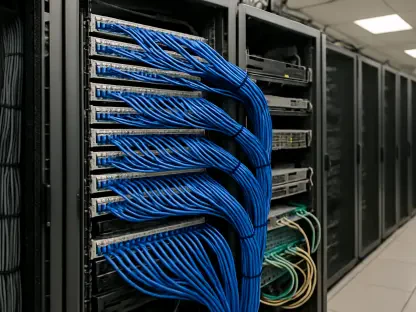The advent of 5G technology marks a significant milestone in the world of communication, promising to revolutionize modern network infrastructure. As the latest advancement in cellular wireless technology, 5G offers unprecedented speed, low latency, and improved connectivity. But what does this mean for network infrastructure, and how will it impact industries and daily life? From enhanced performance in consumer devices to groundbreaking applications in industrial environments, 5G is set to redefine how we interact with technology.
The Basics of 5G Technology
Defining 5G and Its Key Features
5G, short for fifth-generation wireless technology, is poised to deliver multiple enhancements over its predecessors. These improvements include faster data rates, reduced latency, and higher capacity for users. Unlike 4G, which primarily focused on speed enhancements, 5G aims to provide a holistic upgrade in network performance. This transformative technology operates on three primary frequency bands: low-band, mid-band, and high-band, also known as millimeter-wave. Each frequency band caters to different use cases, from broad coverage to ultra-fast connectivity, thus ensuring that 5G can accommodate a wide array of applications, ranging from mobile phones to IoT (Internet of Things) devices.
The multi-faceted approach of 5G ensures that it can adapt to various needs, delivering tailored solutions for different scenarios. Low-band 5G excels in providing extensive coverage with moderate speed, making it ideal for rural and suburban areas. Mid-band 5G strikes a balance between speed and coverage, suitable for urban environments. High-band 5G, although it offers the fastest speeds, has limited range and is primarily used for specific high-data-rate applications in dense urban areas. These characteristics make 5G a versatile technology, capable of transforming the entire spectrum of network infrastructure.
Spectrum Utilization and Network Slicing
One of the notable aspects of 5G is its efficient spectrum utilization. By leveraging a broader range of frequencies, 5G can support more devices simultaneously, a critical factor given the growing number of connected devices. Network slicing further enhances this capability by allowing the creation of multiple virtual networks within a single physical network, each tailored to specific requirements. This innovation ensures that different applications receive the appropriate resources, optimizing performance without sacrificing overall network efficiency. For instance, a critical healthcare network can be isolated from a high-traffic entertainment service, ensuring that both operate flawlessly.
Network slicing offers unparalleled flexibility, enabling service providers to meet diverse customer needs. This adaptability is foundational in transforming modern network infrastructure by ensuring that various sectors—be it healthcare, entertainment, manufacturing, or transportation—can rely on a custom-fit network slice that meets their unique demands. This capability helps mitigate congestion and enhances operational efficiency, making network slicing a cornerstone in the 5G revolution. From critical emergency services to everyday consumer applications, network slicing ensures each use case is catered to with precision.
Impact on Enterprise IoT and IIoT
Enabling Smart Industries
5G technology is set to revolutionize the Industrial Internet of Things (IIoT) by providing the necessary bandwidth and low latency required for real-time data processing. Industries like manufacturing and logistics can now deploy smart sensors and devices that communicate instantly, allowing for predictive maintenance, enhanced automation, and increased efficiency. In smart factories, for example, 5G enables the seamless integration of robotics, AI, and machine learning, ensuring optimal performance and minimal downtime. This connectivity also supports remote monitoring and control, granting industries unprecedented oversight and operational agility.
The concept of smart industries relies heavily on robust, reliable, and fast communication networks. With 5G, factory floors can be outfitted with a plethora of interconnected devices, each playing a crucial role in optimizing production processes. Predictive analytics, powered by real-time data from these devices, can preemptively address equipment failures and inefficiencies. Coupled with AI-driven automation, this creates a sophisticated ecosystem where human intervention is minimized, and operational excellence is maximized. The ripple effects of 5G in industries extend beyond efficiency; they foster innovation and open doors to novel applications and business models.
Enhancing Consumer IoT Applications
Beyond industrial applications, 5G will significantly impact consumer IoT devices. Smart homes and connected devices will benefit from faster communication and greater reliability. This means more efficient home automation systems, enhanced security features, and improved overall user experiences. As more devices become interconnected, 5G will ensure they operate smoothly and without interruptions. Imagine a smart home where door locks, security cameras, thermostats, and entertainment systems work in perfect harmony, all orchestrated by a high-speed, low-latency network.
Such enhancements extend to a plethora of everyday applications. Autonomous vehicles, wearables, and even smart cities will leverage the advanced capabilities of 5G to deliver superior service and functionality. Autonomous vehicles, for instance, require split-second data transmission between the car, other vehicles, and traffic infrastructure to ensure safety and efficiency. In smart cities, 5G can facilitate better traffic management, energy distribution, and emergency services, creating urban environments that are not only more efficient but also safer and more sustainable.
Revolutionizing Mobile Connectivity
Performance Gains and User Experience
For everyday users, 5G promises a dramatic improvement in mobile internet speeds and reliability. Streaming high-definition video, engaging in real-time gaming, and utilizing augmented reality (AR) and virtual reality (VR) applications will become smoother and more immersive experiences. With 5G, the world of digital entertainment will undergo a transformation, offering content creators and consumers new avenues for innovation and engagement. Moreover, 5G’s low latency enables near-instantaneous data transmission, making it particularly beneficial for applications that demand real-time interaction. Telemedicine, where prompt and reliable communication can be life-saving, stands to gain immensely from this leap forward.
The enhanced user experience extends beyond higher speeds and smoother interactions. The reliability of connections in densely populated areas, where 4G networks often struggle, will see a significant upgrade. This means fewer dropped calls, better voice quality, and faster internet access in urban centers packed with users. The implications for daily life are profound, as the ubiquitous availability of high-speed internet will change the way people work, play, and stay connected.
The Role of Beamforming and MIMO
Beamforming is an advanced technique employed in 5G networks to direct signals precisely to where they are needed, enhancing connection quality and reducing interference. Unlike traditional broadcasting methods that spread signals in all directions, beamforming focuses the wireless signal towards specific receiving devices. This method ensures that devices receive strong and reliable signals, even in densely populated areas or challenging environments like urban canyons. In essence, beamforming not only improves the quality of connections but also optimizes the use of available spectrum, making 5G networks more efficient and robust.
Massive MIMO (multiple-input, multiple-output) further boosts 5G’s capabilities by using multiple antennas to send and receive more data simultaneously. This technology significantly increases network capacity and allows for better handling of high traffic volumes, ensuring a consistent user experience. Massive MIMO plays a crucial role in supporting the numerous connected devices that 5G networks will need to accommodate. By enabling multiple data streams to be transmitted and received concurrently, massive MIMO enhances network efficiency and resilience. Together, beamforming and massive MIMO form the technological backbone that makes 5G a game-changer in modern telecommunications.
Challenges and Solutions in 5G Deployment
Infrastructure Requirements and Development
Deploying 5G networks requires substantial infrastructure upgrades. The higher frequency bands used by 5G, especially millimeter-wave, have shorter ranges and are more susceptible to obstacles like buildings and trees. To mitigate this, a denser network of small cells and enhanced macro cells is necessary, involving considerable investment and planning. Small cells are essentially lower-power cellular radio access nodes that extend coverage and increase capacity in concentrated areas. These small cells must be strategically placed to ensure network continuity and efficiency, requiring meticulous planning and substantial financial resources.
Additionally, integrating 5G into existing network structures presents its own set of challenges. Operators must carefully manage the transition to ensure compatibility and interoperability between 4G and 5G networks. The integration process involves updating the current infrastructure to support the new technology while maintaining service for existing users. This delicate balance requires innovative solutions and strategic project management to avoid downtime and disruptions. As network providers navigate these challenges, they must also consider future-proofing their infrastructure to accommodate the inevitable evolution of technology beyond 5G.
Addressing Security Concerns
With the increased complexity and interconnectivity of 5G networks comes heightened security risks. Protecting data and preventing cyberattacks are paramount as more devices and critical services come online. Network providers must implement robust security protocols, including advanced encryption, secure identity management, and continuous monitoring. The expanded attack surface that comes with 5G necessitates a more proactive and comprehensive approach to cybersecurity. As the volume and variety of connected devices increase, so do the potential entry points for malicious actors, making rigorous security measures indispensable.
AI and machine learning play critical roles in enhancing network security. These technologies can analyze network traffic patterns, detect anomalies, and respond to potential threats more quickly and accurately than traditional methods. By leveraging AI, network providers can implement adaptive security measures that evolve with emerging threats. This proactive approach can identify and mitigate threats before they compromise the network, ensuring the integrity and reliability of 5G services. As cyber threats become more sophisticated, the role of AI and machine learning in network security will only grow in importance.
Advancements in Virtualization and Cloud Integration
Network Function Virtualization (NFV) and Software-Defined Networking (SDN)
5G technology leverages virtualization techniques such as Network Function Virtualization (NFV) and Software-Defined Networking (SDN) to enhance network performance and flexibility. NFV allows network functions to be executed on virtual machines rather than specialized hardware, making the network more adaptable and easier to manage. This approach not only reduces costs associated with physical infrastructure but also enables quicker deployment of new services. NFV facilitates agility, allowing network providers to allocate resources dynamically based on current demands, thus optimizing network performance and reliability.
Software-Defined Networking (SDN) complements NFV by providing a flexible, programmable network architecture. SDN decouples the control plane from the data plane, allowing network administrators to manage traffic flows centrally. This centralized control simplifies network management and enhances scalability, making it easier to implement changes and deploy new services. Together, NFV and SDN provide a robust foundation for 5G networks, enabling them to meet the diverse and evolving demands of modern applications and services. These technologies ensure that 5G networks are not only powerful but also adaptive and future-ready.
Edge Computing and Cloud Integration
Edge computing and cloud integration are crucial components in the 5G ecosystem, bringing computational power closer to data sources. By processing data at the network edge, latency is minimized, and real-time applications are supported more effectively. This is particularly important for applications requiring immediate analysis and response, such as autonomous driving, remote surgery, and smart city infrastructure. Edge computing reduces the reliance on centralized data centers, distributing processing tasks and enhancing overall efficiency and resilience.
Cloud integration takes this a step further by providing scalable, on-demand resources that can adapt to fluctuating workloads. By leveraging cloud infrastructure, 5G networks can dynamically allocate resources to meet the demands of various applications, ensuring optimal performance. This synergy between edge computing and cloud integration creates a powerful framework that supports the diverse and data-intensive applications envisioned for the 5G era.
The arrival of 5G technology marks a major breakthrough in the realm of communication, poised to significantly transform modern network infrastructure. As the latest evolution in cellular wireless tech, 5G offers extraordinary speed, minimal latency, and enhanced connectivity. But what implications does this hold for network infrastructure, and how will it influence industries and our daily lives? For starters, 5G’s enhanced capabilities will dramatically improve the performance of consumer devices, from smartphones to IoT gadgets. Imagine downloading an HD movie in seconds or enjoying seamless augmented and virtual reality experiences. In day-to-day life, this means faster, more reliable internet access, which can transform everything from entertainment to education.
On the industrial side, 5G opens up new possibilities for smart factories, autonomous vehicles, and advanced healthcare technologies. The promise of near-instantaneous data transfer will allow machines to communicate and operate with remarkable efficiency, leading to increased productivity and safer work environments. Moreover, cities will harness 5G to boost smart infrastructure, improving public transport, energy management, and public safety. This fifth-generation technology will enable real-time monitoring and more efficient resource management, making urban living more sustainable. Overall, 5G is set to redefine how we interact with technology across diverse aspects of our lives, laying a robust foundation for a connected future.









